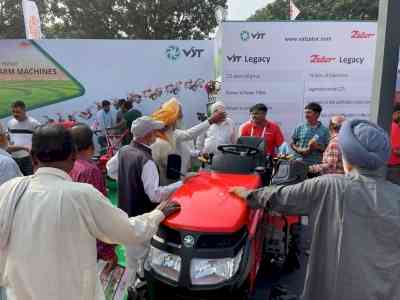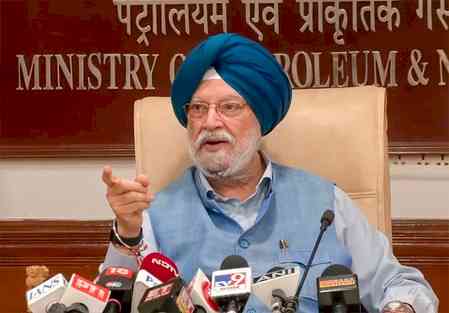12 Punjab, Haryana districts see over 84% reduction in stubble burning
Twelve districts of Punjab and Haryana, the biggest contributors to the food basket of India, covering three lakh acres of farmland of 50,000 farmers in 300 villages, has resulted in over 84 per cent reduction in stubble burning this season.

VISHAL GULATI
Chandigarh, Nov 6 (IANS) Twelve districts of Punjab and Haryana, the biggest contributors to the food basket of India, covering three lakh acres of farmland of 50,000 farmers in 300 villages, has resulted in over 84 per cent reduction in stubble burning this season.
This became reality with the Crop Residue Management (CRM) project, a community-driven initiative of CII Foundation launched initially in 19 villages in 2018, covering 16,000 acres of farmland in Punjab under its Cleaner Air, Better Life initiative.
A spokesperson for the Confederation of Indian Industry (CII) told IANS on Sunday that under the project farmers are advised and supported to adopt the environment-friendly alternatives through interventions focussed on creating awareness about the hazards of stubble burning, offering them viable alternatives, and supporting them in adopting those viable alternatives.
In 2021, the project covered 226 villages and 2 lakh acres and resulted in 84 per cent reduction in stubble burning in the intervened farmlands.
Sharing his experience by adopting ecological techniques for handling residue, Gurdarshan Singh, a marginal farmer with 2.5 acres in Mandour village in Nabha block of Punjab's Patiala, said he had been burning 100 per cent of the stubble due to the lack of knowledge of the alternatives to handle stubble.
He got associated with the CII Foundation's Crop Residue Burning initiative in 2020 and hasn't burned stubble since then.
As a small-scale farmer, he shares that he could not afford to purchase the required machinery.
Earlier, he was spending close to Rs 2,800 per acre on managing stubble, which was a drain on his already-meagre resources.
After associating with the crop residue management project, he started utilising machines from the Tool Bank and underwent training provided by the project.
The knowledge, along with the availability and affordability of agricultural tools has helped him tremendously.
Gurdarshan has been making savings of Rs 1,000 per acre on crop residue management and says that the air in the village feels much fresher and more breathable now.
Asking farmers for a behavioural change, Rajesh Kumar, 36, a farmer with five acres of farm in Dholu village of Fatehabad district in Haryana, learnt about the crop residue management initiative in 2019.
He began participating to learn more about the alternatives to stubble burning and the support the CII Foundation could offer. As a marginal farmer with limited financial means, Rajesh found the Tool Bank very useful.
He could now easily access advanced agriculture tools needed to manage paddy waste such as Superseeder and Rotavator, which were unaffordable earlier.
With this assistance, Kumar decided to treat the paddy stubble ex-situ.
He claims that the Happy Seeder, Mulcher, Zero Till, and MB Plough have all been very useful in managing crop residue.
Enumerating the success story, Seema Arora, CEO, CII Foundation, said CII is working to bring industry resources, both financial and technical, to support community initiatives at the grassroots.
This has helped popularise alternate technological solutions among farmers. In the villages where CII is working, incidents of stubble burning have drastically reduced. Other farmers are learning from the experience, creating a positive cycle of change, she added.
Batting for bringing in a synergy between agriculture and industry, Vice President of India, Jagdeep Dhankhar, last week said at the inaugural session of CII Agro Tech India 2022 here that it could be done by bringing all relevant stakeholders to one platform.
CII Agro Tech India 2022 focuses on sustainable agricultural technologies, enhancing productivity and innovations for growth. It will conclude on Monday.
Punjab and Haryana are the host states of Agro Tech India 2022, while the UT of Jammu and Kashmir is a partner state. The event consists of 246 exhibitors, including 27 international exhibitors from four countries.
With land area of only three per cent of the net cultivated land of the country, Punjab contributes 25-35 per cent of rice and 38-50 per cent of wheat to the central pool of foodgrain. The state ranks fourth in the world in the terms of productivity and first in India amongst all the other states.
Haryana's contribution to agriculture is such that 14 crops are being purchased under the minimum support price (MSP), the highest in the country.
At CII Agro Tech India 2022, Clean Seed Agricultural Technologies from Saskatchewan in Canada showcased an example of innovation in agriculture.
The company is the creator of a portfolio of patented technologies that created the SMART Seeder MAX with its multipurpose solutions such as managing straw and accurate seed and fertilizer placement in combination with the unique no-tillage practices.
Recently the company has entered into a Letter of Intent with the Northern Farmers Producer Company Limited Mega Farmer Cooperative to launch the SMART Seeder MINI-MAX in India.
Upon successful completion of the activities within the LOI, FPO will market and distribute 1,000 SMART Seeder MINI-MAX machines from 2023-2025 in Punjab and Haryana.
Northern Farmers Mega FPO is a leading organisation of 43 farmer cooperatives (FPOs) involving more than 12,000 farmer members from four states in northern India.
With the earth on edge, the synergy between agriculture and industry is a ray of hope for clean air and better life.
(Vishal Gulati can be contacted with vishal.g@ians.in)


 IANS
IANS 








